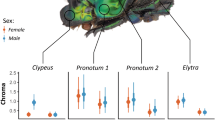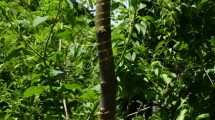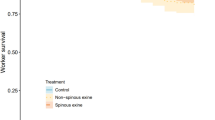Abstract
In the presented paper the development of horse chestnut scale insect,Pulvinaria regalis Canard, was studied a on red horse chestnut (Aesculus x carnea) in the urban area of Bonn. Secondly, the scale insect growth was determined on sycamore maple (Acer pseudoplatanus) and horse chestnut (Aesculus hippocastanum) at different temperatures in the laboratory.
The field population displayed an insignificant linear increase in body length between July and beginning of December. No growth was observed between December and March but between mid of March and beginning of May the body size increased exponentially. By setting up a frequency distribution of the anal plate length and by simultaneous measurement of new and old anal plate during molting it was possible to separate different developmental stages. The length of the anal plates of first instar crawlers/settlers ranged between 0.030 and 0.054 mm, that of the second and third instar nymphs between 0.066 and 0.090 mm and 0.102 to 0.150 mm, respectively. The anal plate length of fourth instar adult females differed between 0.162 and 0.246 mm, whereas those of male puparians ranged between 0.075 and 0.098 mm. Since the cuticula ofP. regalis is very extensible, the separation of different developmental stages was only reliable by using the measure of the strongly sclerosed anal plate. Until 12. August first instar crawlers/settlers and till 29. September second instar nymphs were observed on red horse chestnut in the field. Female third instar nymphs were noticed between 9. September and 28. April and fourth instar adult females from 31. March on.
In the laboratoryP. regalis individuals on horse chestnut and sycamore maple did only growth at 18°C and fluctuating temperature of 20/14°C (16/8 h). The growth was heavily affected at warm temperatures of 26°C and scale insects lived only a few weeks. Only at the fluctuating temperature of 20/14°C (16/8 h) some females laid eggs on horse chestnut and sycamore maple from the 49. and 48. week on.
Zusammenfassung
In der vorliegenden Arbeit wurden die Entwicklungsstadien der Wolligen NapfschildlausPulvinaria regalis Canard im Freiland an einer Rotblütigen Roßkastanie (Aesculus x carnea) im Stadtgebiet von Bonn, sowie das Körperwachstum an Bergahorn (Acer pseudoplatanus) und Roßkastanie (Aesculus hippocastanum) bei unterschiedlichen Temperatubedingungen im Labor untersucht.
Die Freilandpopulation zeigte von Juli bis Anfang Dezember eine geringe lineare, von Mitte Dezember bis Anfang März nahezu keine und von Mitte März bis Anfang Mai eine exponentielle Zunahme der durchschnittlichen Körperlänge. Durch das Aufstellen einer Häufigkeitsverteilung der Analplattenlänge sowie durch das gleichzeitige Messen von neuen und noch nicht abgestreiften alten Analplatten während der Häutungsphase konnte ein Maß zur Abgrenzung der Entwicklungsstadien ermittelt werden. Die Analplattenlänge von Crawlern/Settlern (=erstes Larvenstadium) lagen im Bereich von 0,030–0,054 mm, des ersten und zweiten Nymphenstadiums im Bereich von 0,066–0,900 mm und 0,102–0,150 mm. Bei adulten Weibchen lag die Analplattenlänge zwischen 0,162 und 0,246 mm und bei männlichen Präpuppen zwischen 0,075 und 0,098 mm. Da die Cuticula vonP. regalis sehr dehnbar ist, war eine sichere Stadienzuordnung nur mit Hilfe der stark sklerotisierten Analplatte möglich. Bis zum 12. August waren Crawler/Settler und bis zum 29. September Erstnymphen zu beobachten. Weibliche Zweitnymphen traten vom 9. September bis 28. April und adulte Weibchen ab dem 31. März in Erscheinung.
Im Labor konnte auf den Versuchspflanzen Roßkastanie und Bergahorn ein Wachstum der Körperlänge vonP. regalis-Individuen bei Konstanttemperatur von 18°C und bei Wechseltemperatur von 20/14°C (16/8 h) gemessen werden. Bei einer Konstanttemperatur von 26°C war das Wachstum auf beiden Wirtspflanzenarten gestört und ein Überleben nur für wenige Wochen möglich. Nur in der Temperaturvariante 20/14°C (16/8 h) legten einige Weibchen ab der 49. Woche auf Roßkastanie und ab der 48. Woche auf Bergahorn Eier ab.
Similar content being viewed by others
Literatur
Canard, M., 1968: Un noveauPulvinaria (Hom. Coccoidea) nuisible aux arbres d'alignement dans la région parisienne. Ann. Soc. Ent. Fr. (N. S.)4 (4), 951–958.
de Meirleire, H., 1984: Cochenilles pulvinaires des arbres d'ornement: deux espèces àne pas confondre. Phytoma354, 37–38.
Faber, T.;Şengonca, Ç., 1994: Freilanduntersuchungen über die Biologie der NapfschildlausPulvinaria regalis CANARD an Park- und Alleebäumen im Bonner Raum. Mitteilungen BBA (Braunschweig)301, 475.
Faber, T.; Şengonca, Ç., 1995: Die Wollige Napfschildlaus an Park- und Alleebäumen in rheinischen Städten und Möglichkeiten einer biologischen Bekämpfung. 9. wiss. Fachtagung „Herausforderung für den Pflanzenschutz”, Schwerpunkt „Umweltfreundliche standortgerechte Landwirtschaft” des MURL, Land. Fak. Univ. Bonn, Forschungsberichte (in press).
Harris, K. M., 1970: Horse chestnut scale. Arbor. Ass. J.1 (10), 257–262.
Hodgson, C. J., 1994: The scale insect family coccidae, an identification guide to genera. CAB intern. 639 pp.
Kosztarab M.;Kozar F., 1988: Scale Insects of Central Europe. Dr. W. Junk Publishers, Dordrecht, Boston, Lancaster, 456 pp.
Merlin, J.;Pasteels, J.-M., 1989: La Pullulation des cochenilles pulvinaires en milieu urbain: état de la situation et moyens de lutte. In: Actes du colloque «Gérer la nature?» Trav. Cons. Nat.15 (2), 607–618.
Phillips, J. H. H., 1962: Description of the immature stages ofPulvinaria vitis (L.) andP. innumerabilis (Rathvon) (Homoptera: Coccoidea) infesting peach in Ontario. Can. Ent.94, 497–502.
Phillips, J. H. H., 1963: Life history an ecology ofPulvinaria vitis (L.) (Hemiptera: Coccoidea), the cottony scale attacking peach in Ontario. Can. Ent.95, 372–407.
Şengonca, Ç.;Faber, T., 1995: Beobachtungen über die neu eingeschleppte SchildlausartPulvinaria regalis CANARD an Park-und Alleebäumen in einigen Stadtgebieten im nördlichen Rheinland. Z. PflKrankh. Pflschutz102 (2), 121–127.
Speight, M. R., Nicol, M., 1984: Horse chestnut—a new urban menace? New Scientist1404, 40–42.
Speight, M. R., 1994: Reproductive capacity of horse chestnut scale insect,Pulvinaria regalis Canard (Hom., Coccidae). J. Appl. Ent.118, 59–67.
Sturges, H. A., 1926: The choice of a class intervall. J. Amer. Statist. Assoc.21, 65–66.
Author information
Authors and Affiliations
Additional information
Dedicated to Prof. Dr.W. Schwenke for 75th birthday 22.3.1996.
With 2 tables and 4 figures
Rights and permissions
About this article
Cite this article
Şengonca, Ç., Faber, T. Studies on developmental stages of the horse chestnut scale insect,Pulvinaria regalis Canard (Hom., Coccidae), in the open land and in the laboratory. Anz. Schadlingskde., Pflanzenschutz, Umweltschutz 69, 59–63 (1996). https://doi.org/10.1007/BF01906277
Issue Date:
DOI: https://doi.org/10.1007/BF01906277




